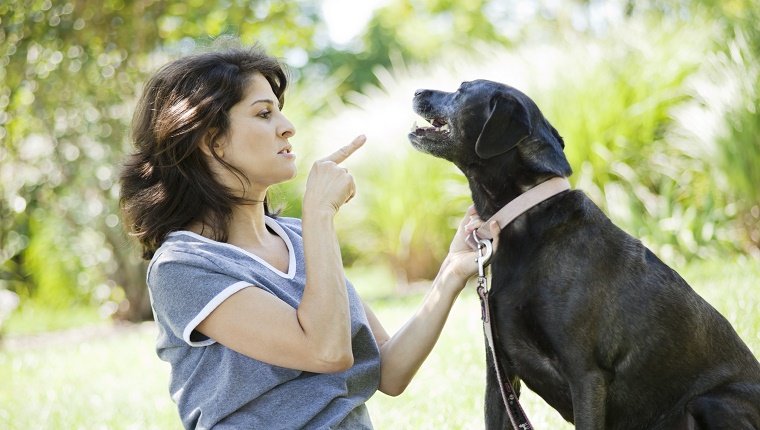When training their dogs, pet parents often make common mistakes such as inconsistency, lack of patience, using punishment-based methods, and not providing enough positive reinforcement. These mistakes can hinder the training process and make it more challenging to achieve desired results.
It’s important for pet parents to understand these common errors and take steps to avoid them in order to effectively train their dogs. By being consistent, patient, and using positive reinforcement techniques, pet parents can create a successful training environment that fosters learning and behavior modification in their canine companions.

Credit: dogtime.com
Mistake #1: Inconsistency
One of the most common mistakes pet parents make when training their dogs is inconsistency. Training a dog requires patience and consistency to effectively reinforce desired behaviors and establish clear expectations. When pet parents are inconsistent in their training methods or fail to follow through with commands, it can lead to confusion and hinder the progress of their dog’s training.
Importance Of Consistency
Consistency is crucial in dog training as it helps dogs understand and retain the behaviors they are being taught. Dogs are creatures of habit and thrive on routine. When pet parents consistently reward and reinforce desired behaviors, it helps dogs understand what is expected of them. Additionally, consistency sets clear boundaries and establishes trust between the pet parent and the dog.
Examples Of Inconsistent Training
Inconsistent training can manifest in various ways, making it difficult for dogs to understand what is expected of them. Here are some examples of inconsistent training:
- Using different commands for the same behavior: For instance, saying “sit” sometimes and “down” other times to command the dog to sit can confuse them and lead to frustration.
- Allowing unwanted behaviors at certain times: If a pet parent allows the dog to jump on guests occasionally but scolds them for jumping at other times, it sends mixed signals and makes it challenging for the dog to understand what is acceptable.
- Not following through with commands: When pet parents give a command but fail to enforce it consistently, such as asking the dog to stay and then allowing them to break the stay command without consequences, it undermines the training process.
- Inconsistent reward systems: Rewarding desired behaviors sporadically or at random intervals can confuse dogs. They may struggle to associate their actions with a specific reward, leading to inconsistent responses.
To avoid these common mistakes, it is important for pet parents to maintain consistency in their training efforts. By establishing clear expectations, using consistent commands, and reinforcing desired behaviors consistently, pet parents can set their dogs up for success in their training journey.

Credit: www.instagram.com
Mistake #2: Lack Of Patience
Mistake #2: Lack of Patience – One of the common mistakes pet parents make when training their dogs is not having enough patience. Dogs learn at different paces, and it takes time and consistency to teach them new behaviors. Patience is key in the training process.
The Role Of Patience In Dog Training
Patience is a vital component of successful dog training. Many pet parents underestimate the time and effort required to train their furry friends, which often leads to frustration and ineffective training sessions. When it comes to teaching your dog new commands or behaviors, it’s important to remember that they are learning and adapting to a new set of rules and expectations. Patience is key in giving them the time they need to fully understand and respond to your training efforts.Tips For Cultivating Patience
To ensure a successful training experience, here are a few tips for cultivating patience when working with your dog: 1. Set realistic expectations: Understand that training takes time and consistency. Dogs learn at their own pace, so it’s essential to set realistic goals and be patient throughout the process. Avoid rushing or getting frustrated if your dog doesn’t immediately grasp a new command. 2. Break training sessions into short intervals: Dogs have a limited attention span, so it’s best to keep training sessions short and focused. Aim for 5 to 10-minute intervals multiple times a day rather than one long session. This will help keep your dog engaged and prevent them from becoming bored or overwhelmed. 3. Use positive reinforcement: Dogs respond best to positive reinforcement, such as treats, praises, and petting. Reward your dog for demonstrating the desired behavior or following a command correctly. This will not only motivate them but also strengthen the bond between you and your furry companion. 4. Practice consistency: Consistency is crucial in dog training. Use the same commands and gestures consistently, and ensure that all family members are on the same page regarding training methods and expectations. Inconsistency can confuse your dog and hinder their progress. 5. Stay calm and composed: Dogs are highly receptive to their owner’s emotions. If you become frustrated, impatient, or angry during a training session, your dog will sense it, and it may hinder their ability to learn. Stay calm, composed, and patient throughout the training process, even if your dog makes mistakes. By cultivating patience and incorporating these tips into your training routine, you’ll create a positive and effective learning environment for your furry friend. Remember, patience is a virtue when it comes to training your dog, and the results will be well worth the time and effort invested.Mistake #3: Punishment-based Methods
One common mistake that pet parents make when training their dogs is relying on punishment-based methods. Punishment-based training involves using physical force, intimidation, or harsh reprimands to discourage unwanted behavior. While these methods may seem effective in the short term, they can have negative effects on the dog’s overall behavior and well-being.
Negative Effects Of Punishment-based Training
Punishment-based training can lead to several negative consequences for dogs. Here are some of the main reasons why this method is not recommended:
- 1. Fear and Anxiety: Dogs that are trained using punishment often develop fear and anxiety-related behaviors. They may become fearful of their owners or strangers, leading to aggression or avoidance.
- 2. Suppressed Behavior: Instead of teaching the dog what to do, punishment-based methods only suppress the unwanted behavior temporarily. This means that the dog may not truly understand what is expected of them, resulting in confusion and frustration.
- 3. Lack of Trust: When a dog is constantly subjected to punishment, their trust in their owner diminishes. This can strain the bond between the dog and the pet parent, making it difficult to establish a positive relationship.
- 4. Increased Stress: Punishment-based methods create a stressful environment for the dog. This can lead to a range of health issues, such as digestive problems, reduced immune function, and an overall decrease in well-being.
- 5. Inhibition of Learning: Dogs that are punished may become hesitant to try new behaviors or explore their environment. This inhibits their ability to learn and develop new skills, which is essential for their growth and mental stimulation.
Alternative Positive Reinforcement Techniques
Fortunately, there are alternative training methods that focus on positive reinforcement rather than punishment. Positive reinforcement involves rewarding desired behaviors instead of punishing unwanted ones. This approach not only enhances the dog’s learning experience but also strengthens the bond between the pet parent and the dog. Here are some positive reinforcement techniques to consider:
- 1. Clicker Training: Clicker training utilizes a clicker, a small device that makes a distinct sound. The sound is paired with a reward, such as treats or praise, to reinforce desired behaviors.
- 2. Treat-Based Training: Using treats as a reward is a popular and effective positive reinforcement technique. Dogs quickly learn to associate the desired behavior with a tasty treat, making them more likely to repeat the behavior.
- 3. Verbal Praise: A simple “good boy/girl” or “well done” with an enthusiastic tone can go a long way in reinforcing positive behaviors.
- 4. Play and Affection: Dogs thrive on attention and affection from their pet parents. Incorporating playtime and cuddles as rewards for desired behaviors can be highly motivating for them.
By employing these positive reinforcement techniques, pet parents can create a rewarding and enjoyable training experience for both themselves and their dogs. It promotes a harmonious relationship built on trust, understanding, and mutual respect.
Mistake #4: Not Providing Proper Socialization
One common mistake pet parents make when training their dogs is not providing proper socialization. Socialization is crucial for dogs to learn how to interact with other animals and people, preventing behavioral issues in the future.
The Importance Of Socialization For Dogs
Proper socialization plays a crucial role in a dog’s overall well-being and behavior. It involves exposing your furry friend to various people, animals, environments, and experiences from an early age. Socialization helps your dog develop positive associations and build confidence, making them more adaptable and friendly in different situations. It is an essential part of their training journey, ensuring they grow up to be well-adjusted and happy companions.Consequences Of Inadequate Socialization
Failing to provide proper socialization can have detrimental effects on your dog’s behavior. When dogs are not adequately exposed to different environments and stimuli, they may become fearful, anxious, or aggressive in unfamiliar situations. This can lead to behavior problems such as excessive barking, aggression towards humans or other animals, and even separation anxiety. Inadequate socialization can also make it challenging for dogs to interact with other animals and people, hindering their ability to enjoy outings, walks, and playdates. To avoid these issues and ensure your dog receives the necessary socialization, it is crucial to expose them to a variety of people, animals, and environments from an early age. This exposure should be done gradually and in a positive and controlled manner to avoid overwhelming or traumatizing your pet. Encouraging positive interactions, rewarding good behavior, and using treats or toys as positive reinforcements can help your dog associate new experiences with pleasure and build confidence. Here are some practical tips to ensure proper socialization for your furry companion:- Start early: Begin socializing your dog as soon as possible, preferably during their crucial developmental stage (around 3 to 14 weeks).
- Introduce gradually: Expose your dog to different people, animals, and environments in a controlled and gradual manner.
- Positive reinforcement: Use treats, praise, and rewards to encourage positive behavior and create positive associations with new experiences.
- Enroll in obedience classes: Obedience classes provide structured socialization opportunities where your dog can interact with other dogs and learn essential commands.
- Create positive experiences: Take your dog on frequent outings to parks, pet-friendly cafes, and other dog-friendly places to expose them to different sights, sounds, and smells.
- Supervise interactions: Ensure all interactions are safe and supervised, especially when introducing your dog to new animals or children.
- Be patient and consistent: Socialization is an ongoing process that requires patience and consistency. Make socialization a part of your dog’s daily routine.
- Seek professional help: If you are unsure about the socialization process or facing difficulties, consult a professional dog trainer or behaviorist.
Mistake #5: Starting Training Too Late
Mistake #5 pet parents make when training their dogs is starting too late. It’s important to begin training early to avoid the dog losing interest or becoming bored with learning new behaviors.
The Optimal Time To Start Training
If you are a pet parent, it’s important to understand that starting training too late can have negative consequences on your dog’s behavior and overall development. The optimal time to begin training your furry friend is as early as possible, ideally when they are still puppies.
Benefits Of Early Training
Early training is crucial for dogs as it sets a strong foundation for their behavior and obedience. By starting training at a young age, you can shape their behavior and teach them important commands and manners. Here are some benefits of early training:
- Socialization: Early training allows your dog to interact with other dogs, animals, and humans in a controlled environment. This helps them develop proper social skills, reducing the chances of aggression or fear towards others.
- Bonding: Training provides an opportunity for you and your dog to establish a strong bond. Through positive reinforcement and mutual trust, your pet learns to rely on you for guidance and support.
- Prevention of undesirable behaviors: With early training, you can address and prevent undesirable behaviors such as chewing, biting, and excessive barking. This helps create a harmonious environment for both you and your furry companion.
- Confidence building: Training boosts your dog’s confidence as they successfully learn new commands and behaviors. This confidence extends to other areas of their life, making them more resilient and adaptable.
- Improved communication: Early training teaches your dog to understand and respond to your cues and commands. This enhances communication between you, allowing for a smoother and more enjoyable pet-parent relationship.
Remember, the early stages of a dog’s life are crucial for their development, and training plays a vital role in shaping their behavior. Start training your furry friend as early as possible to enjoy a well-behaved and obedient companion.

Credit: www.facebook.com
Frequently Asked Questions On 8 Common Mistakes Pet Parents Make When Training Their Dogs
What Is A Common Mistake People Make When Trying To Train Their Dogs?
A common mistake people make when training their dogs is inconsistency, lack of patience, and using punishment-based methods. It’s important to be consistent with commands and use positive reinforcement techniques instead.
What Is The Hardest Thing To Train A Dog To Do?
Cleaning up after playtime is one of the hardest things to train a dog to do. Teaching them to pick up toys or other trash around the house can be challenging but rewarding.
What Makes A Bad Dog Trainer?
A bad dog trainer uses punishment-based methods instead of positive reinforcement techniques. They may rely on physical punishment or intimidation rather than being patient and consistent in their training approach. Consistency and patience are key in effective dog training.
What Is The Number One Rule In Dog Training?
The number one rule in dog training is consistency and patience. It’s important to stay consistent with the commands or cues you’re teaching your dog. Avoid confusing them by using different cues for the same behavior. Stick to one cue and be patient with their learning process.
Conclusion
To ensure successful dog training, pet parents need to avoid common mistakes that can hinder progress. Firstly, inconsistency in commands and cues can confuse dogs, so it’s important to stick to one cue and be consistent. Secondly, punishment-based training methods should be avoided, as they can have negative effects on your furry friend.
Additionally, lack of patience and not providing enough mental stimulation can hinder your dog’s learning process. And finally, training sessions should be kept short and engaging to prevent boredom. By avoiding these common mistakes, pet parents can set their dogs up for success in their training journey.







